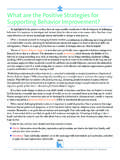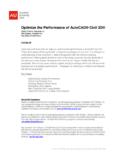Transcription of Challenges in applying the ISO 26262 for driver …
1 Challenges in applying the ISO 26262 for driver assistance systems Bernd Spanfelner, T V S D Automotive GmbH, Garching;. Detlev Richter, T V S D Automotive GmbH, Garching;. Dr. Susanne Ebel, Robert Bosch GmbH, Leonberg;. Dr. Ulf Wilhelm, Robert Bosch GmbH, Leonberg;. Dr. Wolfgang Branz, Robert Bosch GmbH, Schwieberdingen;. Carsten Patz, Robert Bosch GmbH, Schwieberdingen;. Abstract The development of electronic, electric and programmable electronic (E/E/PE) systems is amongst other things subject to the IEC 61508 for the consideration of functional safety.
2 In this, functional safety aims for the correct functioning of a technical system with the goal of avoiding potential safety critical situations caused by HW and SW failures. What generally is not considered in the safety standards is the prevention and restriction of safety critical situa- tions based on the functional insufficiency of the driver assistance systems (DAS). The au- tomobile specific characteristic of the IEC 61508, the ISO 26262 , is no exception in this re- gard. However especially radar-, video-, or ultrasound-based functions can additionally cause potential safety critical situations coming from weaknesses in the estimation, interpre- tation and prediction steps necessary to realize driver assistance behavior.
3 In this case the consequences are comparable to those of HW and SW failures and may also be safety criti- cal. From our understanding these weaknesses are fundamental and not avoidable no matter what future developments in sensor technology and computing power we will see. Especially the necessary interpretation of other traffic participants' actions and the prediction of their future behavior will never be sufficiently complete to avoid misbehavior under all circums- tances. 1 Introduction The increasing need for safety applications in cars together with a high demand for unique selling points drive the development of driver assistance systems (DAS).
4 With a growing number of road users and cars becoming faster and more powerful, today's traffic partici- pants encounter more and more dangerous situations. driver assistance systems intend to support the driver in situations with a potential risk for accidents. They continuously observe and analyze the driving situation and intervene in or- der to clear dangerous driving situations. 1. Observing and analyzing needs advanced models not only for the mapping of the surround- ing traffic situation through sensor measurements, but also to support a kind of understand- ing the situation'.
5 Available driver assistance functions like ABS and ESP rely for their basic understanding of the vehicles driving state on physical models. These physical models are complete enough to demonstrate the absence of unsafe behavior of the system design. Complete technical specifications can be derived which are needed to demonstrate the cor- rectness of the systems implementation. driver assistance systems reacting on their surrounding environment depend on more so- phisticated models. To generate useful behavior the measurements are not only used to es- timate object attributes, they also need to be interpreted in terms capable of describing all relevant traffic situations.
6 From this basic' interpretation predictions need to be made to an- ticipate the behavior of the driver or other traffic participants. The underlying models are based on assumptions which will not be true in all relevant situations. Without these as- sumptions however a timely action of the driver assistance system will never be feasible. Using assumptions ultimately means, that cases are known where with a given probability unwanted behavior is generated, This unwanted system behavior can also cause potential safety critical situations similar to HW or SW failures.
7 To support the prevention or at least the control of HW and SW failures the ISO 26262 as a new standard for functional safety especially for passenger cars was published in November 2011. This article discusses the impact of models based on assump- tions introducing the above discussed weaknesses to the development lifecycle of the ISO. 26262 and possible implications of this impact. In the following this kind of models are called insufficient'. Furthermore, we outline an option for the treatment of the like systems. 2 ISO 26262 . The International Standard (IS) of ISO 26262 [1] is the adaption from IEC 61508 [2] for the automotive industry.
8 IEC 61508 is titled Functional Safety of Electric- al/Electronic/Programmable Electronic Safety-related Systems (E/E/PE, or E/E/PES)' and is intended to be a basic functional safety standard applicable to all kinds of industry. It defines functional safety as: part of the overall safety relating to the EUC (Equipment Under Control). and the EUC control system which depends on the correct functioning of the E/E/PE safety- related systems, other technology safety-related systems and external risk reduction facili- ties.'. ISO 26262 is titled Road Vehicles Functional Safety' and defines methods and measures to be taken to develop safety relevant functions for vehicles up to and applies to all ac- tivities during the lifecycle of safety related systems comprised of electrical, electronic and software components'.
9 The main scope of ISO 26262 is to avoid E/E failures of these sys- tems. Therefore this standard includes a guidance to avoid or control these systematic and random hardware failures by appropriate requirements and processes and to reduce the ex- pected risk to an acceptable level concerning injury or death of human beings. The ISO 26262 defines methods for classifying safety relevant E/E systems based on ha- zardous events which they may cause, resulting in the ASIL (Automotive Safety Integrity Level). With respect to this for the whole life cycle of the safety relevant system, measures 2.
10 To be taken are given to ensure that such situations are avoided, or at least that their appear- ance is reduced to an acceptable minimum. The key features of ISO 26262 are described in the introduction of each part and listed fol- lowing: ISO 26262 provides an automotive safety lifecycle (management, development, pro- duction, operation, service, decommissioning) and supports tailoring the necessary activities during these lifecycle phases;. ISO 26262 provides an automotive-specific risk-based approach to determine integri- ty levels [Automotive Safety Integrity Levels (ASIL)].






